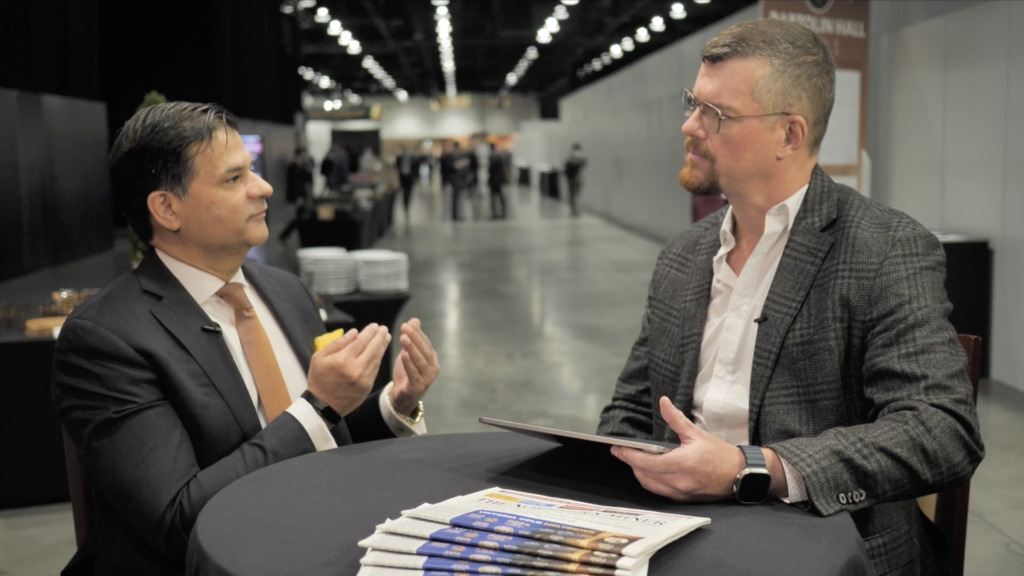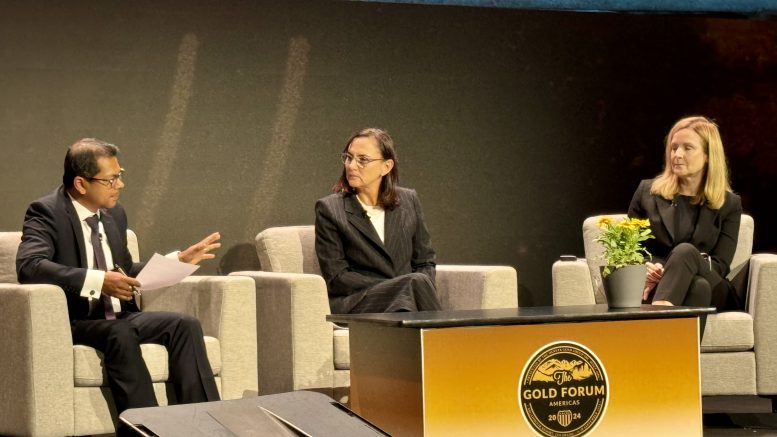As gold prices hit record highs, industry executives are hoping they can convince investors – who haven’t yet piled into gold mining stocks – that they’ll put their cash to better use than they did during the last gold bull run.
“We’re not making the same mistakes again,” the executive director of the Denver Gold Group, Tim Wood, told The Northern Miner at last month’s Gold Forum Americas in Colorado Springs. “This group of managers talks differently about acquisitions and spending. They want to preserve cash, reduce debt, and give better dividends.”
During gold’s last run up to around US$1,920 per oz. in 2011, miners overpaid for acquisitions, and overspent on new builds. Capital spending peaked in 2012 at US$51 billion with little to show in returns, an analysis released last year by Sprott showed. As a result, the GDX, an index of gold mining stocks, is down 40% over the past dozen years, Rick Rule of Rule Investment Media said at the conference.
There have been several recent mergers and acquisitions punctuating gold’s price run to US$2,685.49 per oz., including Gold Fields’ (NYSE: GFI; JSE: GFI) US$1.6-billion purchase of Osisko Mining (TSX: OSK) and AngloGold Ashanti’s (NYSE: AU; ASX: AGG; JSE: ANG) US$2.5-billion acquisition of Egypt-focused Centamin (LSE: CEY). However, that activity doesn’t match the aggressive buying sprees of a decade ago. Executives at the conference stressed that careful planning will avoid overextending, which led to high debt and poor asset management in the past. Others are working to ‘right-size’ the portfolio.
Newmont (NYSE: NEM, TSX: NGT, ASX: NEM, PNGX: NEM), for example, plans to sell non-core assets to raise US$2 billion by 2025, which will help streamline operations and boost shareholder returns.
“We’re buying back shares and cutting debt, but we also ensure that the money we reinvest delivers long-term value,” Newmont CFO Karyn Ovelmen said in a presentation at Gold Forum Americas.
Her colleague, COO Natascha Viljoen, highlighted Newmont’s focus on “value, not volume.” Newmont’s four major projects, including new developments in Ghana and Argentina, aim to generate strong returns, not just increase output, she said.
Growth vs returns
While some consolidation in the sector continues, observers speculate about more deals being inked behind the scenes. Executives The Northern Miner interviewed remain cautious about the risk of overpaying. Barrick Gold (TSX: ABX; NYSE: GOLD) CEO Mark Bristow has maintained consistently that the miner’s not interested in chasing acquisitions with inflated prices.
“We focus on ensuring our projects are profitable, even if prices fall,” Bristow said.

Barrick Gold CEO Mark Bristow maintains a focus on highly profitable projects by keeping a close eye on the cost profile.
Barrick has used a reserve price of US$1,300 per oz. to guide its investments and has returned over US$5 billion to shareholders in five years, all while reducing debt and reinvesting in its core operations, he said. Bristow doesn’t see the company using a reserve price higher than US$1,400 per oz. in the medium term.
Bristow pointed out that the last gold boom saw companies take on large expansions that did not always deliver on their promises and warned that this cycle must be different. He says Barrick focuses on long-term value creation and disciplined spending.
Not all acquisitions trigger buyers’ remorse
Alamos Gold (TSX: AGI; NYSE: AGI), under CEO John McCluskey, made several buys between 2015 and 2017 that were initially seen as expensive, but have since proven their worth.
Alamos has invested US$750 million to expand its Island gold mine in Ontario, and shifted to higher-grade, lower-cost underground mining. These efforts have kept costs low and improved returns for shareholders, the CEO told The Northern Miner.
“We’ve focused on making our mines more productive and efficient,” McCluskey said.
Alamos plans to spend US$65 million on exploration this year to find high-quality gold at low costs.
This time is different
Wasif Latif, chief investment officer at Texas-based Sarmaya Partners, believes mining companies learned hard lessons from past cycles when overspending led to heavy debt and underperforming assets.
“This time, they’re focused on leaner operations, cutting unnecessary costs, and ensuring that every dollar spent translates into value,” he said in an interview.

Sarmaya Partners chief investment officer Wasif Latif (L) in conversation with TNM’s western editor, Henry Lazenby.
He added that disciplined capital use remains key to restoring investor confidence. “Investors want to see responsible spending, lower debt, and higher returns—companies that manage this will thrive,” Latif said.
Latif also highlighted the importance of balancing reinvestment with shareholder returns.
“The smartest miners aren’t just reinvesting in projects; they’re buying back shares and increasing dividends to show that they can grow while rewarding investors,” he said.
With gold prices remaining firm, miners that make smarter decisions on how to spend their cash will likely come out on top.
“We’ve learned from the past,” Bristow said. “The best way forward is through disciplined spending and creating long-term value, not chasing short-term gains.”


Be the first to comment on "Gold majors vow not to repeat decadent spending of a decade ago"